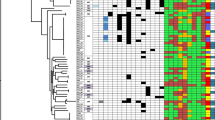Abstract
Pseudomonas aeruginosa is responsible for a substantial fraction of hospital infections. Twenty-five European university hospitals submitted a total of 1411 Pseudomonas aeruginosa isolates for susceptibility testing during 1997 and 1998. The isolates showed highest susceptibility to amikacin (87.5%), meropenem (87.3%) and piperacillin/tazobactam (86.8%). Susceptibility to ciprofloxacin was 73.2%. There was no clear geographical distribution of resistance, although isolates from northwestern Europe tended to be more susceptible than those from southeastern Europe. Isolates that were resistant to one class of antibiotics were also often resistant to at least one other class of antibiotics. Imipenem-resistant isolates were generally not clonally related.
Similar content being viewed by others
Author information
Authors and Affiliations
Consortia
Rights and permissions
About this article
Cite this article
Fluit, A., Verhoef, J., Schmitz, FJ. et al. Antimicrobial Resistance in European Isolates of Pseudomonas aeruginosa . EJCMID 19, 370–374 (2000). https://doi.org/10.1007/s100960050497
Issue Date:
DOI: https://doi.org/10.1007/s100960050497




